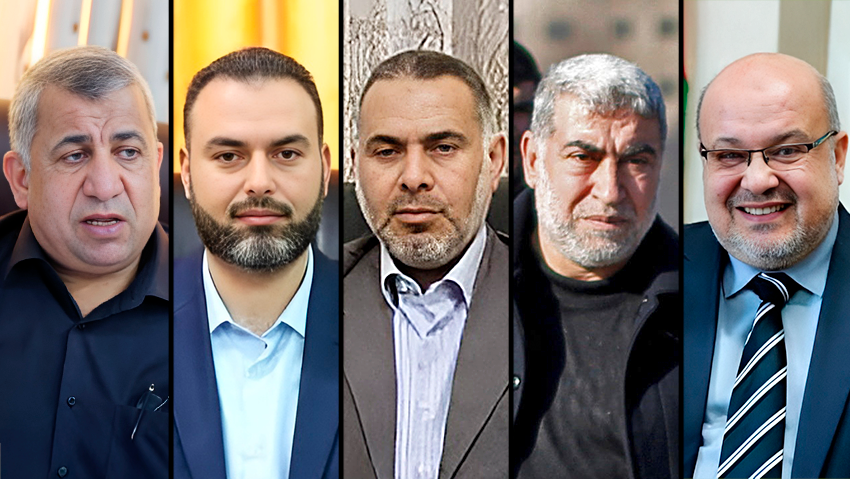Getting your Trinity Audio player ready...
According to all indications, the IDF’s surprise strikes in Gaza on Tuesday overnight had three primary objectives.
The first was to apply military pressure that could break the deadlock in negotiations over hostage releases. Experience within the IDF and Israeli intelligence has shown that such pressure is the most effective way to push Hamas toward flexibility in negotiations.
3 View gallery


IDF Chieif of Staff Lt. Gen. Eyal Zamir and Shin Bet chief Ronen Bar
(Photo: IDF Spokesperson's Unit)
However, using military force as leverage is a gamble with the hostages' lives. In any case, the airstrikes targeted locations that did not pose a direct threat to the hostages' safety according to military and intelligence assessments.
The second objective was to signal to Hamas that Israel is not only targeting its military wing — the terror army that was the focus of previous phases of the war up until the last cease-fire — but also its governance structure.
This was demonstrated by the targeted elimination of five senior officials from Hamas' political and civilian administration, reinforcing the message that Israel makes no distinction between the terror group’s military and political leadership.
More importantly, Israel wanted to warn Hamas that it would not allow the group to rebuild its infrastructure using funds looted from humanitarian aid. The strikes also served as a message to mediators, particularly Egypt, that Israel opposes Hamas remaining in any governing or military capacity in post-war Gaza.
The third objective was to create intense military pressure, coordinated with the U.S., on all remaining elements of the Shiite "axis of resistance," including Yemen’s Houthis, Hamas and Iran.
This coordination stems, in part, from the U.S. administration’s desire to show regional and global actors that President Donald Trump’s threat to "open the gates of hell" was not empty rhetoric but part of a broader strategy that aims to extract a heavy price from Hamas, the Houthis and Iran itself.
3 View gallery


Prime Minister Benjamin Netanyahu and U.S. President Donald Trump
(Photo: AP Photo/Evan Vucci)
The U.S.-Israeli axis is pursuing several goals: securing the hostages’ release, expelling Hamas from Gaza, exacting a price from the Houthis, significantly degrading their ability to disrupt shipping in the Bab el-Mandeb Strait and the Red Sea and pressuring Iran into negotiations for a new nuclear deal that both Trump and Israel could support — one that would block Tehran from rapidly advancing toward nuclear weapons.
Get the Ynetnews app on your smartphone: Google Play: https://bit.ly/4eJ37pE | Apple App Store: https://bit.ly/3ZL7iNv
In recent hours, unconfirmed reports have emerged regarding the sinking of an Iranian intelligence vessel operating in the Arabian Sea and the Bab el-Mandeb Strait. If confirmed, this would mark a direct attack against Iran. In the past, Israel was reported to have sunk the Iranian intelligence and attack ship "MV Saviz," which patrolled off the coast of East Africa and the Bab el-Mandeb Strait.
There is also a fourth reason for the IDF’s overnight attack. According to official statements issued by government sources and the IDF Spokesperson’s Unit on Monday, Hamas has been intensely rebuilding its forces.
Reports indicate the terror group has already reconstituted a fighting force of 20,000 terrorists and is planning further attacks. In the absence of further details, this rationale appears secondary to the first three and likely serves as an additional justification for resuming hostilities in the eyes of the international community.
Reports of Hamas' rebuilding efforts and attack preparations have been known to the IDF for some time. As long as there was hope for a hostage deal, Israel refrained from preemptive strikes, instead maintaining high alert among its air defense and southern border security forces.
Given the current circumstances, it is likely that Prime Minister Benjamin Netanyahu will delay the dismissal of Shin Bet chief Ronen Bar. The intelligence agency is playing a key role in gathering intelligence and identifying targets for the renewed Gaza operation.
Preparations for the offensive have been underway in the Shin Bet for weeks under tight secrecy and it is possible that Netanyahu's announcement regarding Bar’s dismissal was a diversion to maintain the element of surprise ahead of the aerial assault.
The IDF has already said that the operation will continue in the coming days. The fact that it began with an aerial strike suggests a strategy of gradual escalation, giving Hamas opportunities to de-escalate at each stage. However, the aim is for every phase to be executed with maximum surprise — through location, timing, tactics and speed — so that Hamas is unable to regroup.
The campaign is being carried out under the assumption that Hamas will not harm the hostages, as they remain a strategic asset and a form of insurance for the terror group, especially as Israel resumes fighting — likely with increasing intensity, potentially including a rapid ground operation.
However, former hostages have testified that their conditions deteriorated severely, including reports of torture, following major Israeli strikes or the collapse of negotiations. The operation is undoubtedly a high-stakes gamble for the hostages and their safety remains a matter of grave concern.




